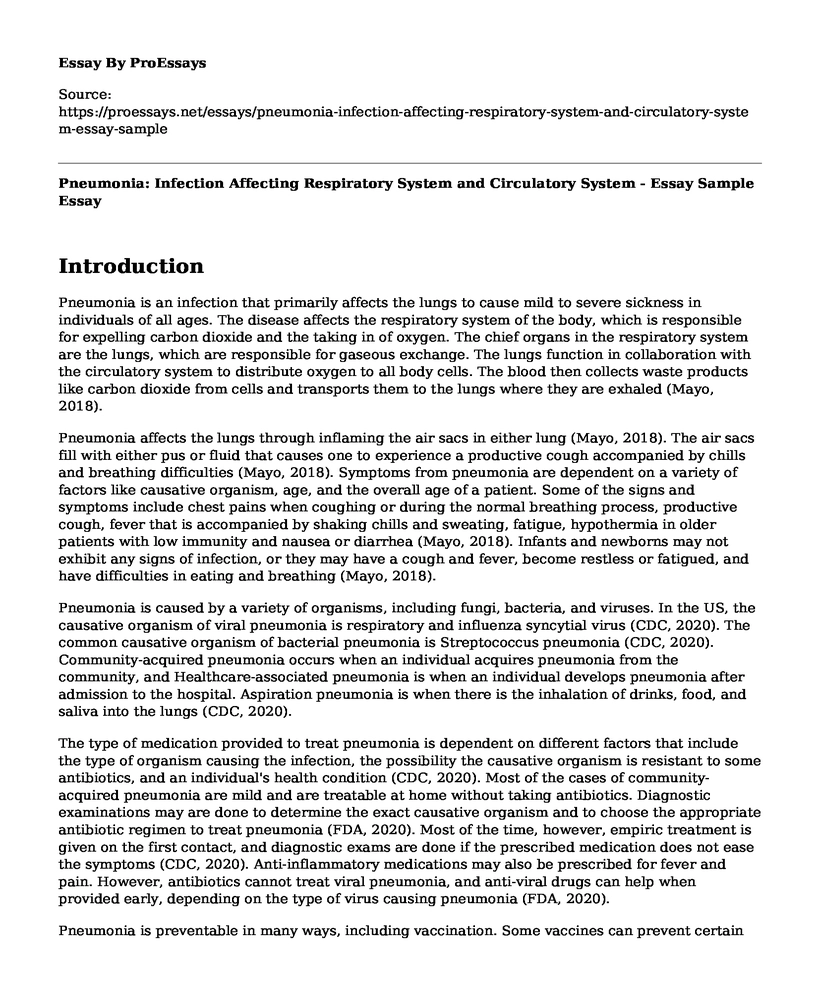Introduction
Pneumonia is an infection that primarily affects the lungs to cause mild to severe sickness in individuals of all ages. The disease affects the respiratory system of the body, which is responsible for expelling carbon dioxide and the taking in of oxygen. The chief organs in the respiratory system are the lungs, which are responsible for gaseous exchange. The lungs function in collaboration with the circulatory system to distribute oxygen to all body cells. The blood then collects waste products like carbon dioxide from cells and transports them to the lungs where they are exhaled (Mayo, 2018).
Pneumonia affects the lungs through inflaming the air sacs in either lung (Mayo, 2018). The air sacs fill with either pus or fluid that causes one to experience a productive cough accompanied by chills and breathing difficulties (Mayo, 2018). Symptoms from pneumonia are dependent on a variety of factors like causative organism, age, and the overall age of a patient. Some of the signs and symptoms include chest pains when coughing or during the normal breathing process, productive cough, fever that is accompanied by shaking chills and sweating, fatigue, hypothermia in older patients with low immunity and nausea or diarrhea (Mayo, 2018). Infants and newborns may not exhibit any signs of infection, or they may have a cough and fever, become restless or fatigued, and have difficulties in eating and breathing (Mayo, 2018).
Pneumonia is caused by a variety of organisms, including fungi, bacteria, and viruses. In the US, the causative organism of viral pneumonia is respiratory and influenza syncytial virus (CDC, 2020). The common causative organism of bacterial pneumonia is Streptococcus pneumonia (CDC, 2020). Community-acquired pneumonia occurs when an individual acquires pneumonia from the community, and Healthcare-associated pneumonia is when an individual develops pneumonia after admission to the hospital. Aspiration pneumonia is when there is the inhalation of drinks, food, and saliva into the lungs (CDC, 2020).
The type of medication provided to treat pneumonia is dependent on different factors that include the type of organism causing the infection, the possibility the causative organism is resistant to some antibiotics, and an individual's health condition (CDC, 2020). Most of the cases of community-acquired pneumonia are mild and are treatable at home without taking antibiotics. Diagnostic examinations may are done to determine the exact causative organism and to choose the appropriate antibiotic regimen to treat pneumonia (FDA, 2020). Most of the time, however, empiric treatment is given on the first contact, and diagnostic exams are done if the prescribed medication does not ease the symptoms (CDC, 2020). Anti-inflammatory medications may also be prescribed for fever and pain. However, antibiotics cannot treat viral pneumonia, and anti-viral drugs can help when provided early, depending on the type of virus causing pneumonia (FDA, 2020).
Pneumonia is preventable in many ways, including vaccination. Some vaccines can prevent certain types of pneumonia and flus (Mayo, 2018). They are, however, given after consultation with a doctor who determines the eligibility of individual patients. Children are also recommended to get vaccinations. Different types of vaccines are available for children below two years and children between the age of two and five who are most susceptible to acquiring pneumonia (Mayo, 2018). To further protect oneself from respiratory diseases, it is crucial to have good hygiene habits like washing hands regularly or using alcohol-based sanitizer to clean hands (Mayo, 2018). People are also advised to cease smoking, which damages the lungs' defense capacity to expel respiratory pathogens. Lastly, it is essential to keep the immune system strong by getting enough rest, exercising often, and eating a balanced diet.
References
Bacterial pneumonia (2020, April 4). Retrieved from https://www.fda.gov/news-events/press-announcements/fda-approves-new-antibiotic-treat-community-acquired-bacterial-pneumonia
Pneumonia. (2018, March 13). Retrieved from https://www.mayoclinic.org/diseases-conditions/pneumonia/symptoms-causes/syc-20354204
Pneumonia. (2020, March 9). Retrieved from https://www.cdc.gov/pneumonia/index.html
Cite this page
Pneumonia: Infection Affecting Respiratory System and Circulatory System - Essay Sample. (2023, May 22). Retrieved from https://proessays.net/essays/pneumonia-infection-affecting-respiratory-system-and-circulatory-system-essay-sample
If you are the original author of this essay and no longer wish to have it published on the ProEssays website, please click below to request its removal:
- Genetic Disease - Case Study Example
- A Gap in Quality Related to Care Coordination for Individuals with Chronic Illnesses
- Effects of Social Media on Physical and Mental Health Essay
- Strategies for Improving Telehealth Paper Example
- Essay on Kids' Pain Misunderstood: Assessing Difficulties in Diagnosing Pains in Children
- 3-Step Approach to Counseling Patients w/ Sexual Dysfunction Concerns - Essay Sample
- Report Example on Mixed Methods in Nursing: Exploring Chronic Pain Challenges







